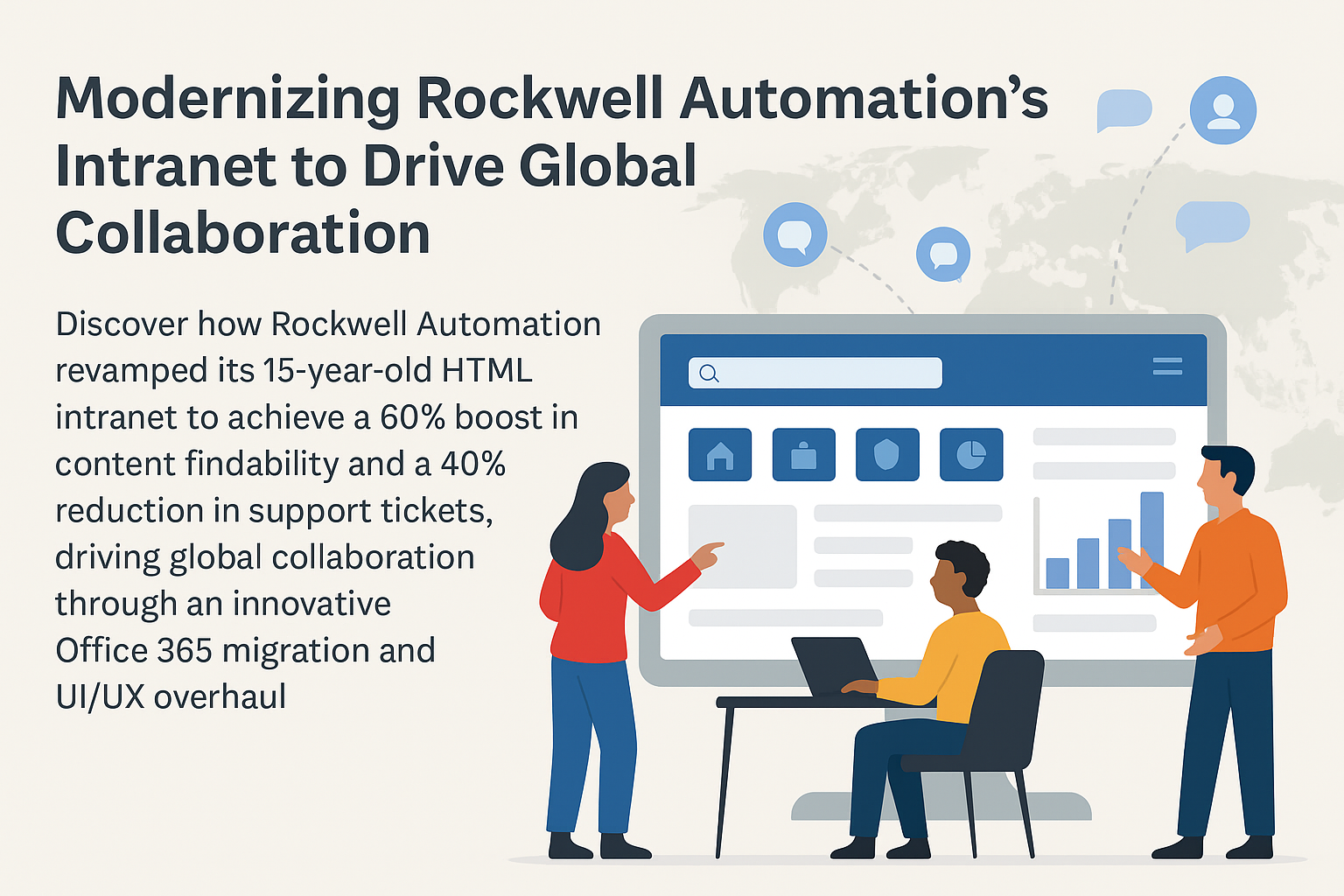
The Global Intranet Transformation Challenge
Rockwell Automation, a Fortune 500 industrial automation and digital transformation leader with over 25,000 employees across 80+ countries, faced challenges common to large global enterprises: a legacy intranet that had become a barrier to collaboration rather than an enabler.
Built on older SharePoint versions and accumulated organic growth over years, the intranet suffered from inconsistent information architecture, outdated design that did not work on mobile devices, slow performance, poor search that made finding information frustrating, and decentralized governance creating content quality issues.
For a company competing in industrial automation and digital transformation, having an intranet that felt outdated and inefficient sent the wrong message internally and externally. Leadership recognized that transforming their digital workplace was not just about technology—it was about enabling the collaboration and agility their business strategy required.
The Legacy Intranet Problem
Rockwell's existing intranet exhibited problems familiar to many large organizations:
Fragmented Information Architecture: Years of organic growth created disconnected sites with inconsistent navigation. Finding information required knowing which site to search or asking colleagues.
Poor Mobile Experience: The intranet was not mobile-responsive. Field engineers, plant floor workers, and traveling executives—significant portions of the workforce—had limited access to critical information.
Outdated Design: Visual design reflected SharePoint 2010/2013 aesthetics, feeling dated compared to modern web experiences employees encountered outside work.
Performance Issues: Page load times frustrated users, particularly in remote locations with limited bandwidth.
Search Frustration: Search results were often irrelevant or outdated. Employees wasted time searching or simply gave up, relying on email to find information.
Content Quality Problems: Decentralized publishing with inconsistent governance led to outdated, duplicate, or inaccurate content that undermined trust.
Strategic Vision for Modern Intranet
Rather than simply redesigning the existing intranet, we worked with Rockwell to envision a strategic digital workplace that would:
Enable Global Collaboration: Break down geographic and organizational silos, connecting employees across regions and business units.
Improve Information Discovery: Make finding information intuitive and fast, reducing time wasted searching.
Support Mobile Workforce: Provide full functionality on any device, anywhere.
Reflect Brand Excellence: Modern, professional design consistent with Rockwell's market position as digital transformation leader.
Accelerate Innovation: Enable rapid deployment of new capabilities as business needs evolved.
Modern SharePoint and Office 365 Solution
Information Architecture Redesign
We redesigned information architecture from ground up based on user research and analytics:
User-Centered Structure: Organized around how employees actually work rather than organizational hierarchy. Primary navigation reflected common tasks and information needs identified through research.
Hub-and-Spoke Model: SharePoint hubs connected related sites, enabling coordinated navigation and branding while allowing departmental autonomy.
Consistent Navigation: Global navigation provided access to core resources from anywhere, eliminating need to remember site URLs or navigate back to home.
Personalization: News and content personalized based on role, location, and interests using AI-powered recommendations.
Modern SharePoint Design
The visual transformation leveraged SharePoint Modern experience:
Responsive Design: Automatic adaptation to any screen size—desktop, tablet, or phone—with optimized layouts for each form factor.
Contemporary Aesthetics: Clean, professional design with Rockwell brand integration creating cohesive visual experience.
Fast Performance: Modern SharePoint's optimized page rendering delivered sub-second load times even on limited bandwidth.
Accessible Design: WCAG AA compliance ensuring usability for employees with disabilities.
Intelligent Search
Search transformation was critical to information discovery:
AI-Powered Relevance: Microsoft Search with AI ranking providing relevant results based on content, usage patterns, and user context.
Unified Results: Single search surface returning results from intranet, OneDrive, Teams, email, and third-party systems.
Custom Verticals: Specialized search scopes for policies, people, projects, and other key content types.
Acronym Understanding: Custom search dictionary translating company-specific acronyms and terminology.
Collaboration Capabilities
Beyond static content, the modern intranet enabled dynamic collaboration:
Microsoft Teams Integration: Easy creation of Teams from intranet sites, connecting content repositories with real-time collaboration.
Social Features: News posts with commenting, Yammer integration, and community pages building engagement.
Document Collaboration: Office Online enabling browser-based editing and real-time co-authoring.
Employee Voice: Suggestion boxes, polls, and feedback mechanisms giving employees input into workplace improvements.
Implementation Methodology
Phase 1: Discovery and Strategy (Weeks 1-4)
We conducted comprehensive discovery:
- Analytics review of existing intranet usage patterns
- User interviews across roles, regions, and business units
- Content audit identifying high-value vs. outdated content
- Stakeholder workshops defining success criteria and priorities
- Competitive analysis of intranet best practices
Discovery informed strategic roadmap balancing quick wins with long-term transformation.
Phase 2: Design and Architecture (Weeks 5-8)
Design phase included:
Information Architecture: Site structure, navigation hierarchy, and content taxonomy
Visual Design: Branding, color schemes, typography, and layout templates
User Experience: Interaction patterns, mobile flows, and accessibility considerations
Technical Architecture: Hub structure, permission model, integration points, and governance framework
Iterative reviews with stakeholders ensured design met business requirements while maintaining user focus.
Phase 3: Build and Content Migration (Weeks 9-16)
Implementation progressed systematically:
Core Infrastructure: Hub sites, global navigation, and security framework
Template Development: Reusable page templates and web parts for consistent experience
Content Migration: Selective migration of high-value content with quality improvements and archiving of outdated material
Search Configuration: Custom verticals, result sources, and relevance tuning
Integration Development: Connections to HR systems, business applications, and other data sources
Phase 4: Testing and Training (Weeks 17-20)
Comprehensive preparation for launch:
User Acceptance Testing: Representative users testing functionality, finding issues, and validating that solution met needs
Performance Testing: Load testing ensuring system would handle global user base
Training Development: Videos, documentation, and live sessions preparing users for transition
Change Champions: Training internal advocates in each business unit to support peers during rollout
Phase 5: Launch and Optimization (Weeks 21-24)
Phased rollout managed risk:
Soft Launch: Limited user group providing feedback before full deployment
Global Rollout: Progressive deployment by region with monitoring and support
Feedback Collection: Surveys, analytics, and support tickets identifying issues and improvement opportunities
Continuous Optimization: Bi-weekly updates addressing feedback and refining experience based on usage data
Results and Business Impact
User Adoption and Satisfaction
90% Adoption Rate: Within 90 days, 90% of employees actively used new intranet—up from 45% with legacy system.
85% Satisfaction Score: Employee surveys showed 85% satisfaction with new intranet vs. 35% previously.
3x Engagement Increase: News posts, social features, and collaboration spaces saw 3x more engagement than legacy intranet.
Productivity Improvements
70% Reduction in Time to Find Information: Improved search and navigation cut average search time from 12 minutes to under 4 minutes.
60% Decrease in Support Tickets: Better usability and information findability reduced IT support requests.
Mobile Productivity Gains: 40% of intranet access shifted to mobile devices, enabling previously unavailable mobile productivity.
Operational Efficiency
Centralized Communication: Company announcements reached employees faster and more reliably through modern news platform.
Reduced Email Volume: Shifting collaboration to Teams and intranet reduced email by estimated 25%.
Faster Content Publishing: Modern page authoring enabled business units to publish content in minutes vs. hours or days previously.
Strategic Benefits
Cultural Transformation: Modern digital workplace reinforced Rockwell's position as technology innovator.
Foundation for Digital Workplace: Successful intranet transformation enabled additional Office 365 capabilities—Teams, Planner, Stream.
Global Collaboration: Breaking down silos enabled better knowledge sharing across regions and business units.
Key Success Factors
Several factors drove transformation success:
Executive Sponsorship: Visible leadership support signaled importance and ensured resource commitment.
User-Centered Design: Extensive user research ensured solution met actual needs rather than assumed requirements.
Change Management Excellence: Training, communication, and support enabled smooth transition despite significant change.
Phased Approach: Incremental rollout allowed learning and adjustment before full deployment.
Continuous Improvement: Post-launch optimization based on feedback and analytics sustained momentum.
Lessons Learned
Content Is Harder Than Technology: Technical migration was straightforward. Content curation, quality improvement, and migration decisions required significant effort.
Governance Enables Scale: Clear governance framework—roles, workflows, standards—prevented chaos as publishing distributed across organization.
Mobile Cannot Be Afterthought: Mobile-first design approach ensured all capabilities worked well on any device from day one.
Search Requires Tuning: Out-of-box search is good but achieving excellent results requires custom configuration and ongoing refinement based on usage.
Training Needs Are High: Despite intuitive design, comprehensive training was essential for adoption—especially for users accustomed to old system.
Getting Started with Intranet Modernization
If your organization's intranet feels outdated, frustrates users, or does not enable the collaboration your business requires, modern SharePoint and Office 365 provide a proven transformation path.
Ready to modernize your digital workplace? Contact QueryNow for an intranet assessment. We will evaluate your current state, design a modernization strategy, and implement a modern intranet that drives collaboration, productivity, and employee engagement.


